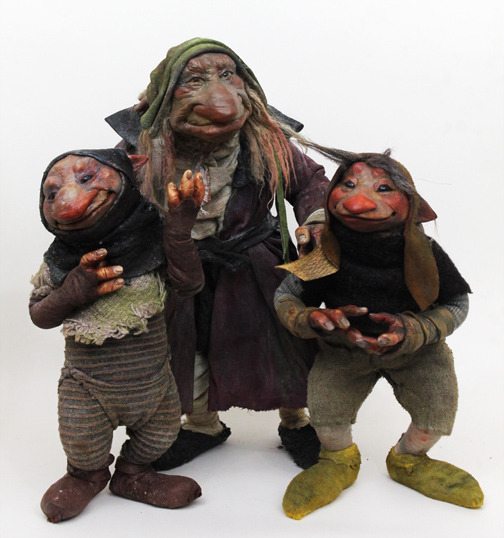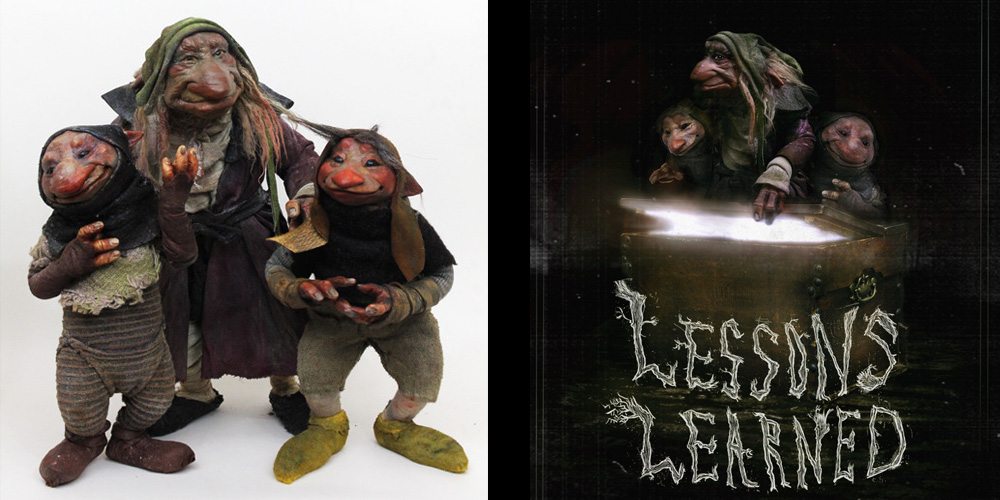

You might think that The Dark Crystal and Labyrinth had a big influence on your childhood, but that is particularly true of Toby Froud. The son of Brian and Wendy Froud, who worked with Jim Henson on both films, Toby actually played the role of the stolen baby in Labyrinth.
Froud is now working on his own live-action puppet movie. He got a startup grant from Heather Henson (daughter of Jim Henson) of IBEX Puppetry, and is raising funds on Kickstarter to help pay for the completion of the film: the money raised will go toward equipment costs, renting space, and paying for artists, post production, and sound editing.
The Lessons Learned Kickstarter campaign has already hit its funding goal, but there’s still time to pledge toward the film. Rewards include the finished film, prints, and even prop boxes from the film. (The three character maquettes have already been claimed.) Froud announced recently that his father Brian has also signed on to design a character, and prints of this character are another available reward.
I asked Froud a few questions about his project, his parents, and becoming a new father.
Liu: What was it like growing up surrounded by (and being a part of) your parents’ work? Apart from actually being in Labyrinth, did you spend much time with their work? Did you ever get to work with your parents on any projects?
Froud: The Labyrinth was certainly not the last time I was surrounded by Faeries, Goblins of my parents work in general. My parents’ home is full of their art and artifacts. From a young age, I was entrusted with the job of handling my father’s artwork. He would bring his recent pieces out of his studio and into the hall; it was then my duty to one by one display them for him, my mother and me to view and discuss (this was still my job during my most recent visit). My mother and I would sit at the kitchen table together making puppets and sculpting.
When I entered university my relationship with my parents shifted towards working together as a team. We have collaborated on pieces of art, puppets and worked on a couple video projects together. We work very well as a team. Now that my own style and skills have formed, together we have presented works in galleries and done talks.

Liu: When I first saw the images of the characters from Lessons Learned, it struck me that they bear a resemblance to the Froud characters I’m familiar with. Was that an intentional artistic choice, or is it your own style? Do you ever feel like you need to get out from under the shadow of your parents’ work?
Froud: As I began to create my own art there was certainly a pull to stand on my own as an artist. With time and growth of my own skill, I started sculpting from my heart and have created my own part of the Froudian style (it just seemed to come naturally). I believe we now, as a whole family complement each other very well. When I first envisioned the Lessons Learned project, I realized I wanted it to be of Froudian puppets for people to connect with again. My intention is to create a world for my audience that would bring a bit of fantasy and magic into their own lives.
Liu: What was the inspiration for Lessons Learned? Did you start with the story and plot, or with the characters and images?
Froud: I am a very visual person; it’s just how my brain works. So when it came to writing the story for Lessons Learned I applied those visual skills and thought. In a way I first saw the scenes, the characters, their emotions and then the story started to form for me. For most people reading the script now, it’s still such a very visual story since a good portion of the boy’s journey will be without dialogue, just an emotional journey.
Now that I think more about the story coming to form, it really lines up with life currently. At the time I was just about to become a father and found myself really looking towards my family for their experience and wisdom and feeling a bit overwhelmed as most new fathers are. So you’ll see a similar trend in this story as a young character dives into a world which is very unfamiliar, respect his elders’ experiences and realize that it’s okay not to understand everything at the present time.
Liu: How did you get involved with Heather Henson and IBEX Puppetry? Was it a deliberate choice to renew a Froud-Henson partnership?
Froud: I don’t know if it was ever a deliberate choice to renew the partnership, it was almost like puzzle pieces falling together. Heather and I were able to connect through our connection and love for her father, Jim Henson. One of my oldest memories of him was walking around my garden as a young boy while Jim was trying to convince me he was Kermi:, at the time I was VERY sure he was wrong. Connecting with Heather, I was fascinated by her drive and love of puppet films and the arts. She strives to help puppeteers and artists bring their visions to life. I had been working on more stationary pieces at the time and I wasn’t necessarily planning on creating a video piece. After speaking with Heather the Lessons Learned story came to me and I couldn’t pass up this opportunity to make it come to life.

Liu: How long does it take to create a live action puppet film compared to, say, a stop motion animation film? I’ve always been partial to the look of stop motion, which has changed a lot since the days of Gumby and the California Raisins. Has puppetry also had significant changes since the days of Labyrinth and The Dark Crystal?
Froud: The time it takes to create live action vs. stop motion is a huge difference. I plan to do filming on set over a week. Stop motion films will take at least a year to shoot, frame by frame (24 per second of film you see, actually).
Both styles really require a lot of time planning, developing the story, forming the characters, deciding how they’ll interact with their world. Generally, a live action hand puppet will only do one or two things well. So, if your character is going to do a whole range of expression or movement you have to plan out how many different puppets or effects it will take to achieve it.
In live action, you certainly have much more flexibility working with your puppets. Working with a puppeteer, you might see different ways for the puppet to move or express an emotion just from the experience of the puppeteer, similar to working with an actor. You can also test out different ways of getting from point A to point B for example with a puppeteer a few times in a few minutes as opposed to an animator that needs to move each joint so precisely over and over again, just to get a glimpse of three seconds.
The Labryrinth and Dark Crystal were really groundbreaking films in puppetry. I will use some very similar techniques for my puppets in Lessons Learned. With the advance of cameras, more detail is picked up, so I’m finding the detail needed to make my puppets come to life is a bit more intense. Also, with access to some digital effects, I have a bit more freedom with the controls, being able to remove rods for example.
In the end both the puppeteers and animators bring the life into a character which makes these films pure magic.
 Liu: I know you work at Laika now in the Puppets department—what’s that like? How long have you been there, and what films have you worked on?
Liu: I know you work at Laika now in the Puppets department—what’s that like? How long have you been there, and what films have you worked on?
Froud: Laika is really a great place to work; I get to be creative every day, I can’t think of a better work situation. I work with such a diverse group of artists that spend most of their waking hours inside a building creating strange and wonderful worlds from literally the ground up. I have worked for Laika for 3 years now, having joined the puppet department for Paranorman—I was a fabricator, mold maker, and costumer. It was a great film to be a part of and my first experience in stop motion animation. For the new film The Boxtrolls which is still currently in production and will be released next year, I worked as a sculptor.
Liu: I hear that you’ve got a newborn son—is this your first, or do you have more kids? Do you plan on putting your own kid(s) into your work?
Froud: I became a father this past March and it has truly been a wonderful journey of discovery for myself and my wife Sarah. Parenthood certainly gives you a different perspective on the world, imagining what your little guy is experiencing. This is our first child and I’m looking forward to the day I can share the Labyrinth with my boy. Although, I imagine he probably won’t believe me that I was that baby in the stripes.
I do hope to put him into some of my work in the future, but currently he makes a fun puppet himself dancing across the bed. We’re certainly going to have some interesting home movies!
For more about Lessons Learned (and to watch two short films Froud made), visit the Kickstarter page.





